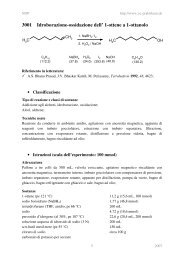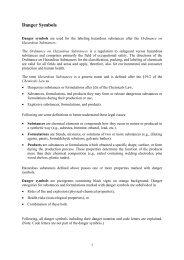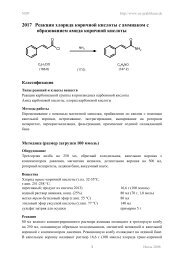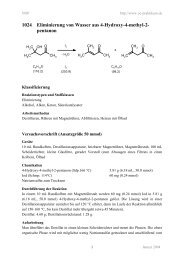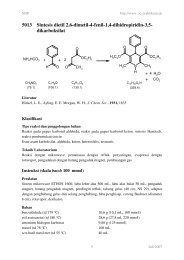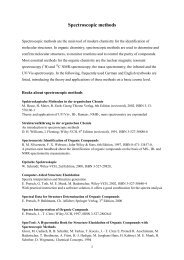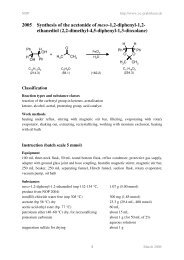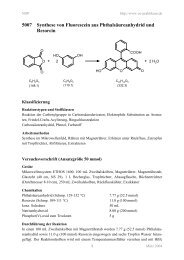5012 Synthesis of acetylsalicylic acid (aspirin) from ... - kriemhild
5012 Synthesis of acetylsalicylic acid (aspirin) from ... - kriemhild
5012 Synthesis of acetylsalicylic acid (aspirin) from ... - kriemhild
You also want an ePaper? Increase the reach of your titles
YUMPU automatically turns print PDFs into web optimized ePapers that Google loves.
NOP http://www.oc-praktikum.de<br />
<strong>5012</strong> <strong>Synthesis</strong> <strong>of</strong> <strong>acetylsalicylic</strong> <strong>acid</strong> (<strong>aspirin</strong>) <strong>from</strong> salicylic <strong>acid</strong><br />
and acetic anhydride<br />
O O<br />
O<br />
COOH<br />
+<br />
OH H2SO4 O<br />
+ CH3COOH O<br />
1<br />
COOH<br />
C 4 H 6 O 3 C 7 H 6 O 3 C 9 H 8 O 4 C 2 H 4 O 2<br />
(120.1) (138.1) (98.1) (180.2) (60.1)<br />
Classification<br />
Reaction types and substance classes<br />
reaction <strong>of</strong> the carbonyl group in carboxylic <strong>acid</strong> derivatives, esterification<br />
carboxylic <strong>acid</strong> anhydride, carboxylic <strong>acid</strong> ester, carboxylic <strong>acid</strong>, phenol, aromatics, <strong>acid</strong><br />
catalyst<br />
Work methods<br />
microwave-assisted reaction, stirring with magnetic stir bar, heating under reflux, filtering,<br />
extracting, shaking out, recrystallizing<br />
Instruction (batch scale 100 mmol)<br />
Equipment<br />
Microwave system ETHOS 1600, glass tube (40 cm, NS 29), 100 mL two-neck flask,<br />
magnetic stirrer, magnetic stir bar, intensive cooler, glass frit (diameter 6 cm), suction flask,<br />
desiccator<br />
Substances<br />
salicylic <strong>acid</strong> (mp 157-159 °C) 13.8 g (100 mmol)<br />
acetic anhydride (bp 138-140.5 °C) 12.8 g (11.9 mL, 125 mmol)<br />
conc. sulphuric <strong>acid</strong> (96%) 3 drops<br />
sodium hydroxide 5 g<br />
ethanol for recrystallizing about 30 mL<br />
aqueous iron(III) chloride solution (0.1 M) a few mL<br />
Reaction<br />
The reaction apparatus consists <strong>of</strong> a 100 mL two-neck flask with magnetic stir bar,<br />
temperature sensor and intensive cooler. A mixture <strong>of</strong> 13.8 g (100 mmol) salicylic <strong>acid</strong> and<br />
12.8 g (11.9 mL, 125 mmol) acetic anhydride is filled in the reaction flask and three drops <strong>of</strong><br />
conc. sulphuric <strong>acid</strong> are added. The apparatus is installed by means <strong>of</strong> a glass tube in the<br />
March 2006
NOP http://www.oc-praktikum.de<br />
microwave system (see "Technical Instructions. Standard refluxing apparatus for microwave<br />
system"). The reaction mixture is heated under stirring for 90 seconds with 900 W to 140 °C.<br />
During the following cooling down the clear yellowish solution solidifies to a compact white<br />
crystalline mass.<br />
Work up<br />
After cooling down to room temperature, the solid is chopped in the flask and stirred for 30<br />
minutes with 50 mL water. Then the solid is sucked <strong>of</strong>f over a glass frit. The filter residue is<br />
washed on the frit three times with 30 mL water each, thereby the washing water runs through<br />
without vacuum, finally, it is thoroughly sucked <strong>of</strong>f. The filtrate is disposed.<br />
The crude product on the frit is analyzed with a 0.1 M iron(III) chloride solution for possibly<br />
contained salicylic <strong>acid</strong> (see analytics). If the test result is negative, the product is dried in the<br />
desiccator over granulated sodium hydroxide under reduced pressure until mass constancy.<br />
During the drying procedure also still adherent acetic <strong>acid</strong> is removed.<br />
Yield: 16.0 g (88.8 mmol, 89%); mp 136 °C<br />
For further purification, i.e. if the product still contains salicyl <strong>acid</strong>, it is recrystallized <strong>from</strong><br />
ethanol/water: The crude product is dissolved under heating in about 30 mL ethanol, then<br />
about 60 mL hot water are added through the reflux condenser. The mixture is slowly cooled<br />
down and the flask is put in an ice bath to complete the crystallization. The product is sucked<br />
<strong>of</strong>f and dried.<br />
Yield: 14.6 g (81.0 mmol, 81%); mp 136 °C<br />
Comments<br />
Without addition <strong>of</strong> sulphuric <strong>acid</strong> the yield <strong>of</strong> the crude product amounted to about 83%, still<br />
containing bigger volumes <strong>of</strong> salicylic <strong>acid</strong>. After recrystallization the yield was below 70%.<br />
If the humid product is pre-dried on a filter paper under the hood, considerably less drying<br />
agent is needed in the desiccator.<br />
Waste management<br />
Waste disposal<br />
Waste Disposal<br />
aqueous filtrate solvent water mixtures, halogen free<br />
mother liquor <strong>from</strong> recrystallization solvent water mixtures, halogen free<br />
Time<br />
About 1 hour without recrystallization<br />
Break<br />
Before work up<br />
Degree <strong>of</strong> difficulty<br />
Easy<br />
2<br />
March 2006
NOP http://www.oc-praktikum.de<br />
Analytics<br />
Temperature-time-dependence <strong>of</strong> the reaction steps in the microwave field<br />
Temperatur [°C]<br />
160<br />
140<br />
120<br />
100<br />
80<br />
60<br />
40<br />
20<br />
<strong>Synthesis</strong> <strong>of</strong> the <strong>acetylsalicylic</strong> <strong>acid</strong><br />
0<br />
0<br />
0 200 400 600<br />
Zeit [sec]<br />
800 1000 1200<br />
3<br />
T1 [°C]<br />
Energie [Watt]<br />
Iron(III) chloride test<br />
About 10 mg <strong>of</strong> the substance are dissolved in about 5 mL ethanol and 1 to 2 drops <strong>of</strong> a 0.1 M<br />
aqueous iron(III) chloride solution are added. An intensive violet colour <strong>of</strong> the solution shows<br />
the presence <strong>of</strong> salicylic <strong>acid</strong>.<br />
Gas chromatography is not applicable as analysis method, since both salicylic <strong>acid</strong> as well<br />
as the product decarboxylate on the GC column.<br />
1000<br />
900<br />
800<br />
700<br />
600<br />
500<br />
400<br />
300<br />
200<br />
100<br />
Energie [W]<br />
March 2006
NOP http://www.oc-praktikum.de<br />
1 H NMR spectrum <strong>of</strong> the product (300 MHz, CDCl3)<br />
8.2<br />
8.0<br />
8.0<br />
7.0<br />
7.8<br />
(ppm)<br />
6.0<br />
7.6<br />
(ppm)<br />
δ (ppm) Multiplicity Number <strong>of</strong> H Assignment<br />
8.12 dd 1 6-H<br />
7.62 dt 1 4-H<br />
7.36 dt 1 5-H<br />
7.15 dd 1 3-H<br />
2.35 s 3 CH3<br />
7.26 solvent<br />
5.0<br />
7.4<br />
4<br />
4.0<br />
7.2<br />
3.0<br />
2.0<br />
6<br />
5<br />
7<br />
COOH<br />
1<br />
O<br />
4<br />
2<br />
3<br />
O<br />
8 9<br />
March 2006
NOP http://www.oc-praktikum.de<br />
13 C NMR spectrum <strong>of</strong> the product (300 MHz, CDCl3)<br />
160<br />
140<br />
120<br />
100<br />
δ (ppm) Assignment<br />
170.06 C-7<br />
169.78 C-8<br />
151.25 C-2<br />
134.90 C-4<br />
132.52 C-6<br />
126.18 C-5<br />
124.01 C-3<br />
122.24 C-1<br />
21.02 CH3<br />
76.5-77.5 solvent<br />
(ppm)<br />
80<br />
5<br />
60<br />
6<br />
5<br />
7<br />
40<br />
COOH<br />
1<br />
O<br />
4<br />
2<br />
3<br />
20<br />
O<br />
8 9<br />
March 2006
NOP http://www.oc-praktikum.de<br />
IR spectrum <strong>of</strong> the product (KBr)<br />
1,12<br />
1,0<br />
0,9<br />
0,8<br />
0,7<br />
Egy 0,6<br />
0,5<br />
0,4<br />
0,3<br />
0,2<br />
0,1<br />
0,00<br />
4000,0 3000 2000 1500 1000 400,0<br />
cm -1<br />
(cm -1 ) Assignment<br />
3300 - 2500 O-H-valence, carboxylic <strong>acid</strong>, superimposed by<br />
C-H-valence<br />
1760 C=O-valence, ester<br />
1700 C=O-valence, carboxylic <strong>acid</strong><br />
1600, 1575 C=C-valence, arene<br />
6<br />
March 2006



